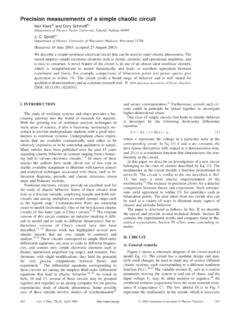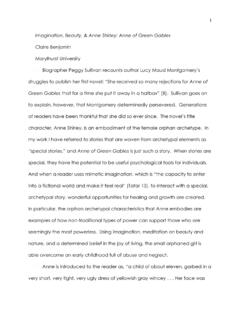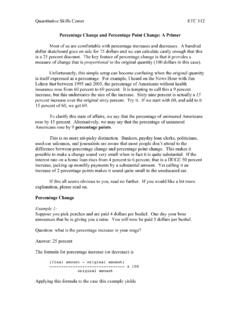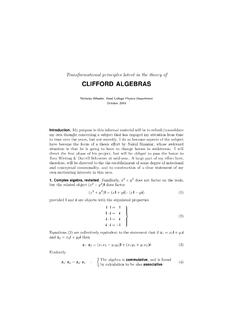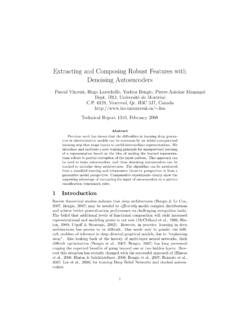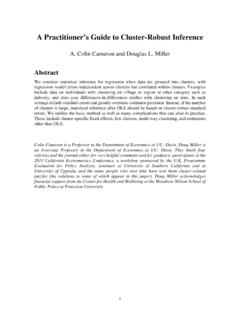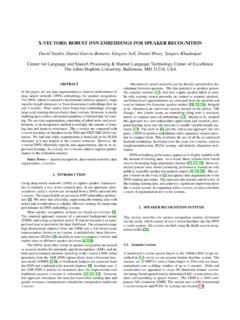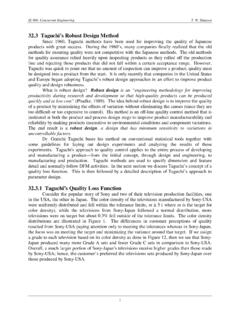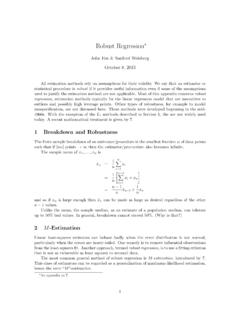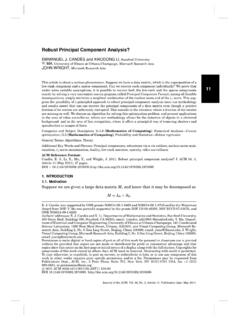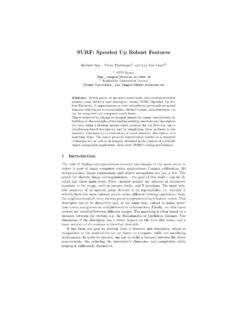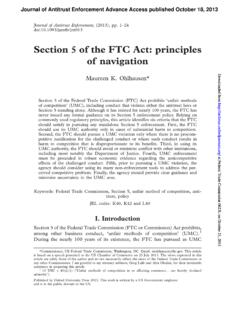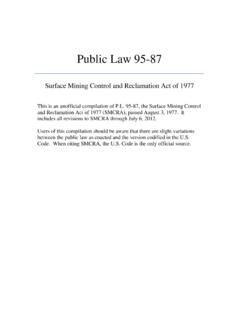Transcription of Section 8 Heteroskedasticity - Reed College
1 ~ 75 ~ Section 8 Heteroskedasticity Basics of Heteroskedasticity We have assumed up to now (in our SR and MR assumptions) that the variance of the error term was constant across observations. o This is unrealistic in many or most econometric applications, especially in cross sections. Heteroskedasticity occurs when different observations have different error variance. Effects of Heteroskedasticity o We will see that OLS estimators are unbiased and consistent in the presence of Heteroskedasticity , but they are not efficient and the estimated standard errors are inconsistent, so test statistics using the standard error are not valid Detection of Heteroskedasticity o At a visual level, we can look for Heteroskedasticity by examining the plot of residuals against predicted values or individual explanatory variables to see if the spread of residuals seems to depend on these variables.
2 O There are tests that formalize these visual descriptions, regressing the squared residuals on predicted values or explanatory variables. Dealing with Heteroskedasticity : Two choices o Use inefficient OLS estimator but use robust standard errors that allow for the presence of Heteroskedasticity This is the easiest and most common solution o Use weighted least squares (WLS) to calculate efficient estimators, conditional on correct knowledge of the pattern of Heteroskedasticity This is the better solution if we know the pattern, which we usually don t Effects of Heteroskedasticity Simple regression (multiple is similar) model with Heteroskedasticity : 122,0,var,cov,0,.iiiiiiijyxeEeeeei j o Covariance matrix of error vector is a diagonal matrix, but not a scalar matrix. ~ 76 ~ We derived earlier that the OLS slope estimator could be written as 2221121,NiiNinnNiiixxebxxwe with OLS is unbiased under Heteroskedasticity : o 221221 NiiiNiiiEbEwewE e o This uses the assumption that the x values are fixed to allow the expectation of e to go inside the product.
3 Variance of OLS under Heteroskedasticity is not the usual formula o 212111221221221varvarvarcov,.NiiiNNNiiij ijiijjiNiiiNiiiNnnbwewewweewxxxx o If 2i is constant, then we can take it out of the numerator summation and the numerator summation on deviations of x cancels one of the denominator summations, leaving the usual formula: o If the variance is not constant, we can t do this and the ordinary variance estimator is incorrect. OLS is inefficient with Heteroskedasticity ~ 77 ~ o We don t prove this, but the Gauss-Markov Theorem requires homoskedasticity, so the OLS estimator is no longer BLUE. Detecting Heteroskedasticity The eye-ball test is a simple but casual way to look for Heteroskedasticity o Plot the residuals (or the squared residuals) against the explanatory variables or the predicted values of the dependent variable o If there is an apparent pattern, then there is Heteroskedasticity of the type that the variance is related to x or x.
4 The Breusch-Pagan test is a formal way to test whether the error variance depends on anything observable. o Suppose that 2212,2, z , where the z variables may be the same or different from the x variables in the regression, and h may be any kind of function. o To test this, we regression the squared residuals on the z variables and test the hypothesis that 2 .. S are all zero: 212,2, ..iiSiSiezzv Several possible tests of 02 3:..0SH : Lagrange multiplier test is 221~SNR o Reject homoskedasticity if test statistic > critical value o This is asymptotic test The White test is a test that is similar to the Breusch-Pagan test, using as the z variables o All of the x variables in the original equation o The squares of all of the x variables o Optionally, the cross-products of the x variables. o This leads to lots of variables if K is large o Dummies can t be included as squares The Goldfeld-Quandt test is suitable for samples in which the data can be divided into two groups and with variance differing only between the groups.
5 O Suppose that the groups are A and B with variances 2A and 2B . o Run separate regressions for the two sub-samples A and B and calculate the estimated error variances from the residuals o 22,22 /~ /ABAANKNKBBFF o If the null hypothesis is that 22AB , then the ratio of the estimated variances is the F statistic and we can do a one-tailed or two-tailed test. ~ 78 ~ Must be careful with the two-tailed F test, though, because F tables only report the right-hand tail area and critical values. Make A the sample with the larger variance so that all of the critical area is on the right. The one-tailed test with alternative hypothesis 22AB is just the ordinary F test with the usual critical value. For the two-tailed test, a 5% critical value becomes a 10% critical value because of the possibility that the variance of A is smaller than the variance of B.
6 Heteroskedasticity -consistent standard errors The first, and most common, strategy for dealing with the possibility of Heteroskedasticity is Heteroskedasticity -consistent standard errors (or robust errors) developed by White. We use OLS (inefficient but) consistent estimators, and calculate an alternative ( robust ) standard error that allows for the possibility of Heteroskedasticity . From above, 2212221varNiiiNnnxxbxx under Heteroskedasticity . Logical estimator for variance is 2212221 /var/NiiirobustNnnxxe NKbxxN This compares with the homoskedasticity-only estimator of 21221 /varNiiNhomoskedasticiieNKbxx In matrix terms, the covariance matrix of the coefficient vector is 11 var,robustNNK bXXXX with 21 Niiiie xx Stata calculates the White Heteroskedasticity -consistent standard errors with the option robust in most regression commands.
7 Many econometricians argue that one should pretty much always use robust standard errors because one never can count on homoskedasticity ~ 79 ~ Weighted least squares If one wants to correct for Heteroskedasticity by using a fully efficient estimator rather than accepting inefficient OLS and correcting the standard errors, the appropriate estimator is weight least squares, which is an application of the more general concept of generalized least squares. The GLS estimator applies to the least-squares model when the covariance matrix of e is a general (symmetric, positive definite) matrix rather than 2IN. 111 GLS XXXy The most intuitive approach to GLS is to find the Cholesky root matrix P such that P P is equal to 2 -1. o This gives us , PyPXPe for which the OLS estimator is 11111 transformedGLS bPXPXPXPyXPPXXPPyXXXy o Thus we can use the usual OLS procedure on the transformed model to get the efficient GLS estimator o This estimator is sometimes called infeasible GLS because it requires that we know , which we usually don t.
8 O Feasible GLS is when we use an estimator for rather than the actual value. For the case of Heteroskedasticity , 212220000000N , and the corresponding F matrix is 1210010000100N P Multiplying the X, y, and e matrices by P transforms each observation by dividing x, y, and e by i. ~ 80 ~ Thus, WLS consists of OLS on the transformed model ,** *,,,ijiiiij iiiixyeyx e Note that the constant term is no longer just ones, because each x1 is divided by a different . Because 2var,iie * o Thus dividing each observation by something proportional to the error standard deviation for the observation converts the model to a homoskedastic one. HGL example: o If we divide by ix then the variance of the transformed model is 2 for all observations. o This is why we call it weighted least squares: we weight each observation by the reciprocal of its standard deviation, giving greatest weight to the observations for which the error variance is smallest.
9 If pattern of Heteroskedasticity is unknown, we may estimate a model such as 212,2, and use fitted values as estimates of the error variance of each observation. o This feasible GLS is consistent and asymptotically efficient as long as we have the pattern of Heteroskedasticity specified correctly.


